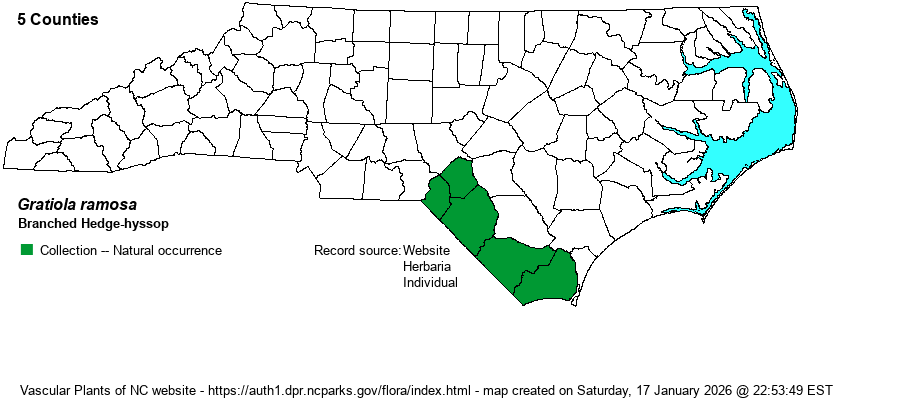| Author | Walter | |
| Distribution | Limited to the southern Coastal Plain, and mainly to the clay-based Carolina bay zone of Hoke, Scotland, and Robeson counties. Ranges southeast to Brunswick County.
This is a Southern Coastal Plain species, ranging north to southern NC, with a recent disjunct record to southern VA and historically to MD, and south to southern FL and west to LA. | |
| Abundance | Very rare and strongly declining; in fact, it is in danger of extirpation from NC without more and better management. Most of the NC NHP records are of poor or historical populations, but Eric Ungberg discovered a very large population in summer 2022 in Brunswick County. The species is only listed in NC as Significantly Rare, supposedly because it is common in FL and not globally rare. | |
| Habitat | In NC, most of the records are from clay-based Carolina bays, both with or without a tree canopy of cypresses. It can occur around shallow pools or wet spots in pine savannas; it is mainly found in shallow ponded areas in acidic soils in high-quality habitats. Most of its populations have suffered from lack or insufficiency of burning or cutting of competing pines and other woody growth, which rapidly invade bays when the water levels drop from drought or over-pumping of nearly wells. |
| Phenology | Blooms in May and June, and fruits shortly after flowering. | |
| Identification | This is a quite small and slender herb, growing only to about 6-8 inches tall, unbranched or at times branched near the top, easily getting overtopped by competing vegetation if not burned or otherwise managed. This species is separated from all others in the genus by it very narrow leaves, which grow in a few opposite pairs along the stem; each leaf is about 3/4-inch long, but only about 1/10-inch wide, rather stiff and thick, sessile or clasping, but with one to several strong teeth on the outer margins. The flowers are standard for the genus, growing mostly singly from leaf axils, with a very short pedicel, and white -- about 1/2-inch long when viewed from the side. To find this species in NC, you likely will need to visit a clay-based Carolina bay, with permission, and look extremely carefully, as this is a low plant and even when in bloom can be hard to spot. It can be attractive in bloom if you find a cluster of plants, but more than likely you can miss their blooming period! The key is to note the narrow and spiny-tipped leaves. | |
| Taxonomic Comments | None
| |
| Other Common Name(s) | None. Note that the plants, at least in NC, are normally not branched, and this seems to be a poor common name. | |
| State Rank | S1 | |
| Global Rank | G4G5 | |
| State Status | SR-P | |
| US Status | | |
| USACE-agcp | FACW link |
| USACE-emp | FACW link |

